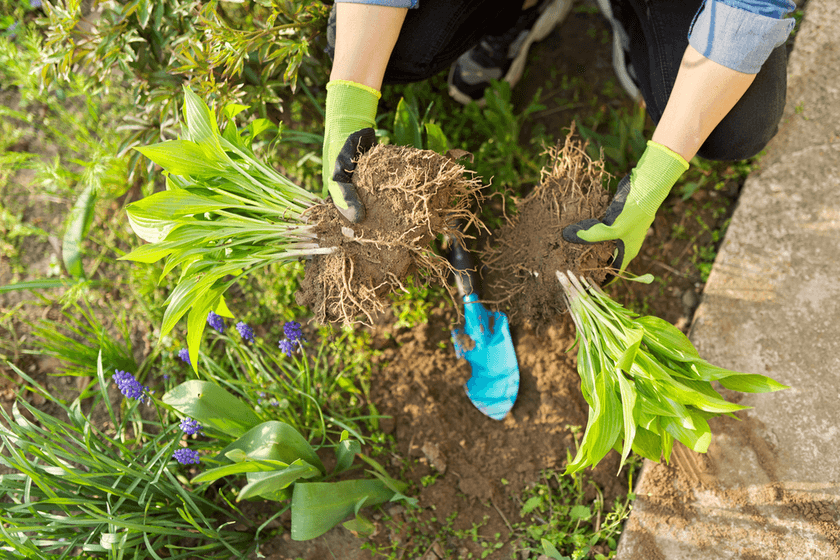People love hostas because they are lovely shade plants. They are easy to grow and give gardens a good foundation. To keep your hosta plants the same size and shape, be sure to divide them. While you’re at it, remove dead plant sections to ensure that your plants continue to look their best. Dividing hostas is easy once you learn how to do it properly.
When to Split Hostas?
When to split hostas? The best time to separate hostas is during early spring or fall. Be sure to split them before the plant spikes have grown too high. If they haven’t grown too high, you can split the plants anytime during the spring or even in the first week or two of summer.
If you decide to wait until fall, then make sure that the plants are in a state when they need less water. In most areas, there’s about a four-week window that’s best for dividing hostas. If you live in a northern climate, plan to divide them in September. If you live in a southern area, then expect to move them during October. Wait until the weather is cool and moist. Keep an eye on the long-range weather predictions.
How to divide hostas? It’s easier to divide the plants when they are smaller. Also, when the plants are smaller, it’s easier to avoid damaging the leaves. If you decide to split your hosta plants in the summer, make sure that they are well-watered for several weeks prior to help them adapt to the shock of being moved.
When Do Hostas Need to Be Divided?
Divide your hosta plants when they become overcrowded and when the middle of a clump begins to die. A general rule of thumb is to divide them every three to four years. This will help your plants maintain their health. If you own hostas that are slow-growing, they may need a bit more time before they’re ready to be divided. Hosta plants that grow quickly may do better if you divide them every two to three years.
When to split hostas? If you only intend to separate your hostas to keep them the same size or to ensure that they’re healthy, then you can divide them every five to 10 years.
What Will You Need to Split Hostas?
How to separate hostas? To separate hostas, you’ll need a shovel, knife, and a few garden tools such as a garden fork or a spade. Make sure that you have access to water for your plants when you need to transplant them.
When you’re splitting a hosta, start by digging up the full root clump if your plants are on the small side. Dig around your hosta plants in a circle. Then, slide the shovel underneath them so that you can lever the clump out of the earth.
After you have the clump out of the ground, you’ll see that it is formed of a number of individual plants. Shake the loose dirt off. This will let you assess the plant’s root system. If the dirt won’t shake off, then wash the clump with water. That way, you’ll be able to see the crowns of your hosta plants.
Once you can see the hosta crowns, break the clumps apart into sections that feature a minimum of three sets of shoots that are growing out of the crowns.
If your hosta plants are large, you’ll need to use a shovel to cut each clump into separate sections. Use caution when digging out the hosta clumps from the hole. With big hosta clumps, it might be easier to divide the plants with a flat spade or a garden fork.
How to separate hostas? Hosta plants feature a clumping root system, which makes them easy to divide. To separate a plant, use a knife to cut from one side of the clump to the other. Cut from the top down. If you have garden tools, you can pry the root clump apart, but you won’t be able to divide the system as precisely as you can when you’re using just a knife.
It’s OK to cut through a hosta plant’s roots because they’ll grow back quickly once you’ve moved the plant to a different location with more space.
How to Split Hostas
You can separate one hosta plant into multiples. In fact, you can split them out to only one bud for each division. However, when you have fewer buds in a division, it will be less likely for the plant to produce blooms during the first year or two following a transplant. If you need to divide your plants to resize them, this won’t make a difference.
Are Hostas Easy to Divide?
Keep in mind that lifting and separating hosta plants sets them back a few years in maturity. How far back you take them depends on how much of their root networks is lost during the process.
When you’re dividing the plants, make sure that every bud or collection of buds has the roots still attached. Also, do your best to avoid damaging the leaves. If you do notice leaf damage during the transfer, remove the damaged leaves.
Where Should You Plant Your Relocated Hostas?
To make sure that your hosta plants thrive, choose a relocation site wisely. Select a shady area with limited amounts of sunlight. Hostas love being moist, so make sure that yours have access to plenty of water.
When replanting separated hostas, include fresh organic matter. This will ensure that your plants hold onto as much water as they can. Fresh soil is good for managing diseases, too.
How to Maintain Hostas
Once you’ve relocated your hosta plants, maintaining them is simple. They need to be watered often. If you let your hostas become dry, it will impede their growth. While hostas are not likely to succumb to disease, slugs may be attracted to them. To fight the pests, consider using slug traps. In fact, you can even use a DIY technique that involves beer. Slugs are attracted to the yeast that’s in beer, so they’ll leave your hosta plants alone and make their way to your beer trap.
You can try natural methods of spreading coffee grounds or eggshells around the garden area featuring your hostas. Both materials are deadly slug barriers. If you want instant results, check your local True Value a great selection of slug control treatment options.
Hostas Get Better With Age When Properly Relocated
Some hosta varieties don’t become mature for five years. When the hosta clump expands, its appearance improves. If hosta plants run out of room, their growth will decrease. However, they don’t usually decline due to a lack of space. If your hosta plants appear to be declining, then they are probably in a poor location with too much sun or too little moisture.
If you want to move hostas to improve the look of your garden, then remove a clump and separate it into thirds or quarters. Place it near its original location with a bit more spacing. This will give the plant enough room. Once the summer months arrive, you probably won’t be able to tell that you divided the plant.
Keep Your Hosta Plants Happy and Healthy
Before dividing your hosta plants, decide how many of them you need and how far back in maturity level to set them back to. Once you start growing hosta plants, you’ll love their big leaves, fullness, and bright green color. To help your hosta plants thrive we recommend a slow release 10-10-10 fertilizer, but make sure to wait a minimum of 3 weeks to allow the hosta to establish a strong root system. Have any questions , visit us at True Value.












